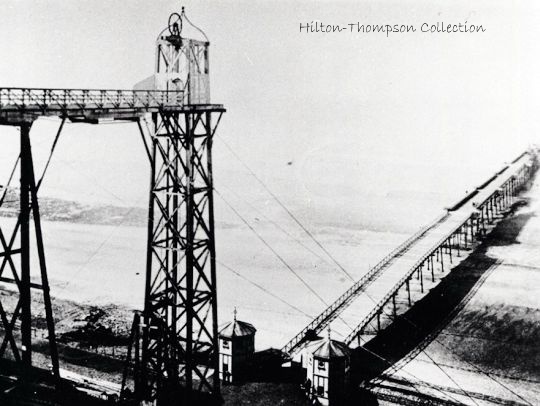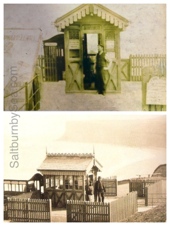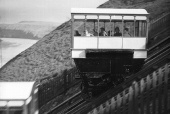Discovering the Cliff Lift - Saltburn's Inclined Tramway
Saltburn by the Sea as a dignified Victorian resort grew up around the former smuggling village of Old Saltburn, when the industrialists of Middlesbrough needed somewhere to escape the dirt & grime and the railways could transport them easily to the coast. By 1870 Saltburn was a fashionable resort rivalling other well known Victorian watering places such as Harrogate and Bath. The town perches on top of the cliffs and access to the beach and the newly constructed pier was always going to be difficult. The problem of getting down to the beach 120ft below the town was entrusted to engineer John Anderson. His original solution was to build a wooden vertical hoist and this remained operational until 1883.
The original Hoist.
Engineered by John Anderson, the Redcar & Saltburn Gazette reported that the hoist was expected to open on June 6th 1870 but it was 1st July 1870 before the hoist was at work daily, fourteen months after the opening of the pier. This somewhat rickety structure allowed up to 20 people in a cage to descend from the town to the beach below. The structure was 120ft high, made of wood and held down by guy ropes. At the cliff top the tower was approached by a narrow walkway. The cage itself was raised or lowered by pouring water into, or out of, a tank which counterbalanced the cage and its passengers.

...'for a halfpenny a head they [were] by and by dropped gently down to the beach for a bathe or a walk, and raised up again in the same easy terms whenever they wish to get back again ...'
The Pier Company was sold to the Owners of the Middlesbrough Estate in August 1883 and the hoist was inspected. The new owners concluded that the hoist, although still functional was occasionally erratic - it is said that the cage had the disconcerting habit of sticking when halfway up - and condemned it as unsafe. Having operated for thirteen years it was demolished in 1883.
The Inclined Tramway

Its replacement was the now renowned water balanced Cliff Lift, probably the oldest of its type still in operation in the UK. Its two cars, each of which is fitted with a water tank beneath, run on parallel tracks. The car at the top of the 71% incline has its tank filled with water until it overbalances the weight of the car 120ft below and proceeds down the incline under its own specific gravity. The double steel wire ropes provide any additional control that is needed. When the car reaches the bottom its water is re-pumped to the top and the process begins all over again. The entire operation is controlled by the brake man from his little cabin at the top of the lift.
Facilities provided at either end of Saltburn Cliff Railway have always varied considerably, and passengers waiting to descend are less fortunate than those waiting to come up from the shore to the town. At the lower station there is a substantial complex, containing a ticket office, waiting room, and engine room, but the only building at the upper terminus is a small hut for the 'brakeman' controlling the operation of the cars. The original cars were of a standard design, capable of seating 10-12 passengers, with an over-body on a triangular sub-frame that housed a 350 gallon water tank. A striking feature of the early cars was the inclusion of stained-glass windows, but these were removed in 1955 when the car bodies were replaced. However when the new aluminium cars were introduced in 1979 (modelled on the original design), this attractive feature was reinstated.
Currently owned and operated by Redcar and Cleveland Borough Council, Saltburn's Cliff Railway continues to be well patronised. Open every weekend from mid March through to October, and daily during the peak season, this is one funicular that looks forward to a secure future.

Photo courtesy of Alan Southworth, 2009, taken on his walk along the Cleveland Way.
John Anderson
As a railway contractor John Anderson was associated with the Stockton and Darlington and the South Durham and Lancashire Union Railways and was one of the first to become involved in the emerging ironstone industry in 1848. In Saltburn he saw the opportunity of making an investment and was one of the first to buy plots of land in Milton and Amber Streets but his most important acquisition was the site on Brittania Terrace/Marine Drive - both now Marine Parade - where he erected the 'Alexandria Hotel', the second most important hotel in the town. In January 1867 he became resident engineer at Saltburn in conjunction with the North Eastern Railway Company, which took over the control of the Stockton & Darlington company. He was involved in the construction of the sewage system in the town, and brought pipes from the new reservoir at Lockwood Beck. Not content with this he wanted to build the first iron pier on the North East Coast.
Anderson formed the Saltburn-by-the-Sea Pier Company in October 1867 and was both designer and contractor for the project.
55 seconds by Tin Man Films
55 seconds is a vertical portrait of Saltburn, seen through the short journeys people make on the UK's oldest water balanced funicular lift to the only remaining pleasure pier in the North-East. Read more about the making of the film and behind the scenes photos on Jan Cawood's blog or subscribe to her YouTube Channel and Flickr Channel for regular updates.
'150' from Tin Man Films UK
'150' celebrates the care and craftsmanship that went into re-creating Britain's oldest working water-balanced cliff-lift, and returning it, with its restored companion, in time for Saltburn's 150th anniversary year.
Jan Cawood of Tin Man Films wanted '150' to convey the wonder of 19th century engineering while also focusing in on human skills. There's some use of modern tools and machinery, but traditional tools and techniques do most of the work - mallet, clamps, wedges, sand-paper and, above all, human hand and effort, lifting, tapping, stirring paint, sanding and, for the other vital ingredient, holding mugs of coffee.
Stanegate Restorations of Haltwhistle carried out the work, led by Ian Yates, who also narrates the film. Scenes of his team are intercut with shots of the December sea-front, snow-covered rails waiting for their carriages to come back, and the expanse of beach, crossed by a few strollers and dogs.
If you have a photo of Saltburn Cliff Lift that you'd like to share please e-mail a copy to us at photo@saltburnbysea.com and we'll include it in our gallery.
Research by Rebecca Hilton. Collecting primary source materials, articles and extracts from books related to the development of both Saltburns and trying to validate them has offered conflicting information, much of which is often difficult to validate as many sources can prove to be unreliable e.g. newspapers or census data. Every effort has been made to ensure that the information on the history of the town presented here is as accurate as possible.












